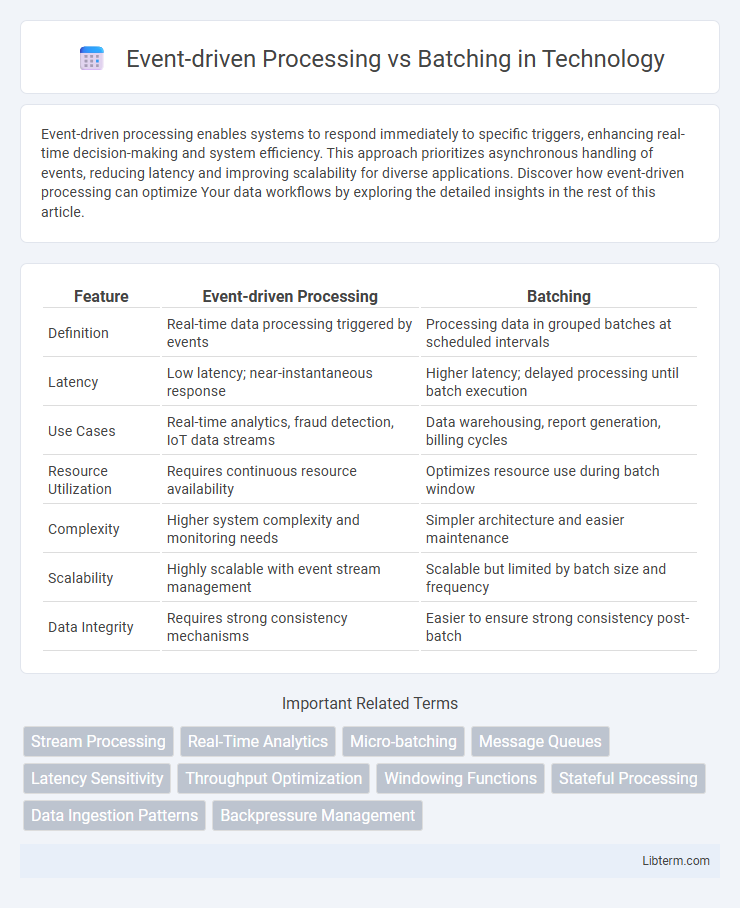Event-driven processing enables systems to respond immediately to specific triggers, enhancing real-time decision-making and system efficiency. This approach prioritizes asynchronous handling of events, reducing latency and improving scalability for diverse applications. Discover how event-driven processing can optimize Your data workflows by exploring the detailed insights in the rest of this article.
Table of Comparison
| Feature | Event-driven Processing | Batching |
|---|---|---|
| Definition | Real-time data processing triggered by events | Processing data in grouped batches at scheduled intervals |
| Latency | Low latency; near-instantaneous response | Higher latency; delayed processing until batch execution |
| Use Cases | Real-time analytics, fraud detection, IoT data streams | Data warehousing, report generation, billing cycles |
| Resource Utilization | Requires continuous resource availability | Optimizes resource use during batch window |
| Complexity | Higher system complexity and monitoring needs | Simpler architecture and easier maintenance |
| Scalability | Highly scalable with event stream management | Scalable but limited by batch size and frequency |
| Data Integrity | Requires strong consistency mechanisms | Easier to ensure strong consistency post-batch |
Introduction to Event-driven Processing and Batching
Event-driven processing handles data in real-time by instantly responding to events or changes, enabling immediate execution and decision-making in applications. Batching, conversely, accumulates data over a specific period before processing it all at once, optimizing resource usage and throughput for large volumes. Understanding these approaches is crucial for designing systems that balance latency, scalability, and efficiency based on workload characteristics.
Core Concepts: Event-driven vs Batch Processing
Event-driven processing handles data as individual events occur, enabling real-time analytics and immediate decision-making by triggering responses to each event independently. Batch processing collects and processes large volumes of data in scheduled intervals, optimizing throughput and resource utilization for non-time-sensitive tasks. Event-driven systems excel in dynamic environments requiring low latency, while batch processing suits scenarios demanding high efficiency over time.
Architecture Overview: How Each Approach Works
Event-driven processing architecture centers on real-time data handling by triggering actions immediately upon event occurrence, using components like event producers, event brokers, and event consumers. Batching architecture collects and processes data in fixed-size groups or time windows, employing batch schedulers, data storage, and processing units to handle accumulated data at set intervals. Event-driven systems prioritize low latency and continuous data flow, while batching systems optimize resource efficiency and throughput with periodic, bulk data processing.
Key Advantages of Event-driven Processing
Event-driven processing offers real-time data handling, enabling immediate responses to events and reducing latency significantly compared to batching. It improves system scalability by processing events asynchronously, allowing continuous data flow without waiting for batch completion. This model enhances fault tolerance through isolated event handling, minimizing the impact of individual failures on overall system performance.
Key Benefits of Batch Processing
Batch processing enables efficient handling of large volumes of data by grouping tasks and executing them during off-peak hours, reducing system load and improving resource utilization. It offers enhanced fault tolerance through retries and checkpoints, ensuring data integrity and reliability in complex workflows. The method's scalability supports processing extensive datasets without real-time constraints, making it ideal for financial reporting, data warehousing, and large-scale analytics.
Challenges and Limitations of Event-driven Processing
Event-driven processing faces challenges such as managing high event volumes that can overwhelm system resources and cause latency spikes. Ensuring event ordering and consistency is complex in distributed architectures, potentially leading to data integrity issues. Moreover, debugging and monitoring become difficult due to the asynchronous nature and lack of clear execution flow.
Challenges and Limitations of Batch Processing
Batch processing faces challenges such as delayed data availability since large data sets must be collected before processing, leading to latency in decision-making. It struggles with scalability and real-time responsiveness, making it less effective for applications requiring immediate insights or continuous data flows. Additionally, batch systems may encounter resource bottlenecks during peak loads, reducing overall system efficiency and increasing processing time.
Best Use Cases: When to Choose Event-driven or Batching
Event-driven processing excels in scenarios requiring real-time data handling, such as fraud detection, IoT sensor monitoring, and live customer interactions, where instant response is critical. Batching is ideal for processing large volumes of data with less time sensitivity, like end-of-day report generation, bulk data transformation, or data warehousing workflows. Choosing event-driven or batching depends on latency requirements, data volume, and system design priorities to ensure optimal performance and resource utilization.
Performance, Scalability, and Latency Comparison
Event-driven processing offers lower latency by handling data in real-time, enabling immediate responsiveness, while batching processes data in bulk, which can introduce delays but improves throughput for large volumes. Scalability in event-driven systems is enhanced through distributed architectures that dynamically allocate resources based on event flow, whereas batching systems scale by optimizing batch sizes and scheduling. Performance in event-driven processing excels for workloads requiring instant reaction, contrasting with batching that optimizes resource utilization and is ideal for periodic, high-volume data processing.
Future Trends in Event-driven and Batch Processing
Event-driven processing is evolving with the rise of real-time analytics, AI integration, and edge computing, enabling faster, more responsive systems that handle streaming data instantaneously. Batch processing continues to advance through improvements in distributed computing frameworks like Apache Hadoop and Spark, optimizing large-scale data processing efficiency and resource management. Emerging hybrid architectures combine event-driven and batch methods, leveraging the strengths of both to support complex workloads and predictive analytics in cloud-native environments.
Event-driven Processing Infographic

 libterm.com
libterm.com